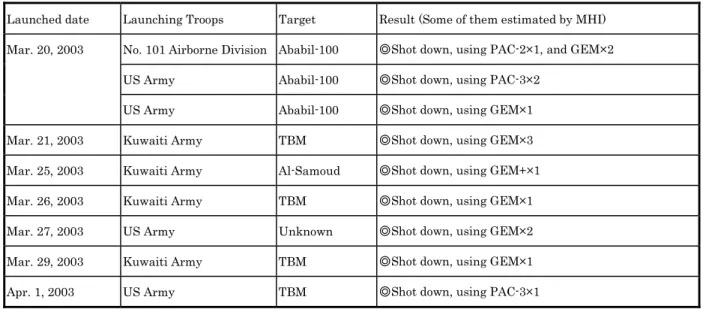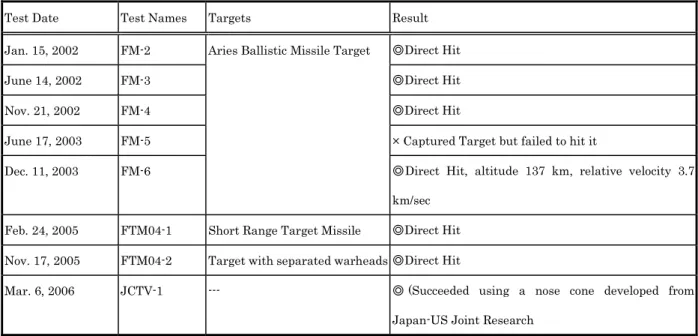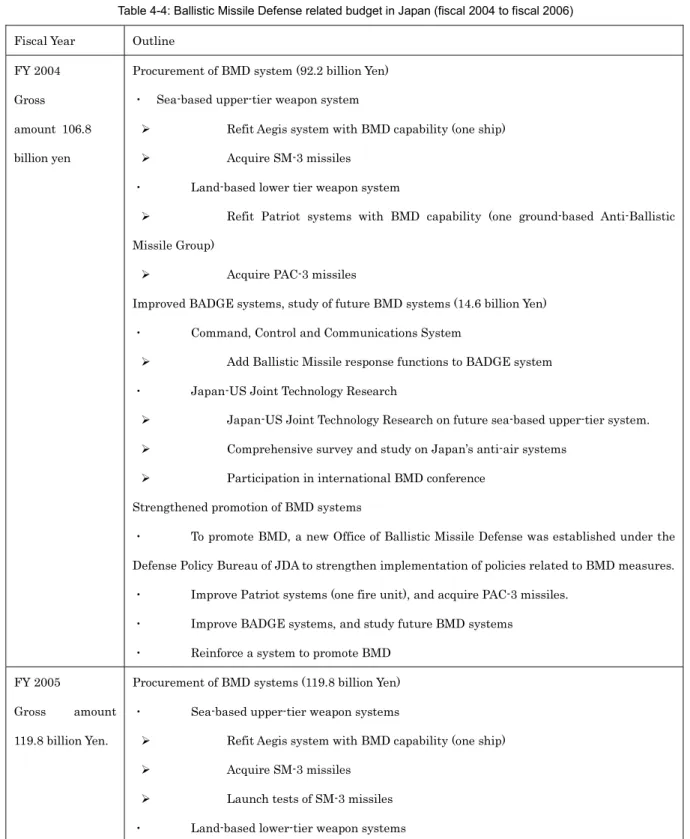However, it is at least clear what North Korea's announcement meant for the international community. As for the return to the Six-Party Talks, North Korea has not withdrawn its condition that the US lift its financial sanctions.
Responding to Missile Threats
Missile Threats and Responses by Specific Countries
The United States was made acutely aware of the need for ballistic missile defense by the Gulf War in 1991. Germany, France, Italy, and the United States began Theater Missile Defense Architecture Studies (TMDAS) in 1987 and agreed to develop MEADS as an air defense system with TMD capability in February 1995 (France later withdrew from this agreement34).
Missile Threats to Japan
It is concerned that North Korea may acquire technologies to equip ballistic missile warheads with nuclear weapons.9. The No Dong is a mobile, liquid-fueled, single-stage ballistic missile North Korea developed from the Scud.
Comprehensive Measures against Missile Attacks
In summary, the comprehensive measures suitable for Japan's response to ballistic missile attacks are (1) deterrence diplomacy, (2) an attitude of deterrence, (3) denial of power (offensive defense), (4) defense capability (active defense) , and (5) damage limitation (passive defense). So it is necessary to build a civil defense system that can handle the launch of ballistic missiles.
BMD Initiative as Active Defense Measures
Japan’s Ballistic Missile Defense
In September 1998, Japan and the United States agreed to start a joint technology study of the NTWD, which received Japan's Security Council and government approval the following December. According to the Chief Cabinet Secretary Statement on Joint Japan-US Technology Study of Ballistic Missile Defense in December 1998, the transition from technical research stage to development stages and then implementation stages would be determined separately "after a thorough review of the technological feasibility of BMD also as the concept of Japan's future national defense. Behind such a cautious approach to the joint technology study, the intention of the Japanese government seemed to maintain flexibility in future policy-making.
Due to its Diet Resolution on the Peaceful Uses of Space, the resolution of Japan's information gathering satellites is about the same as available commercial satellites. Japan should rely on the US's already established strategic information gathering and analysis capabilities at the moment. For example, in the case of BMD, the commander of the ASDF Air Defense Force would be designated as the commander of a Joint BMD Task Force.
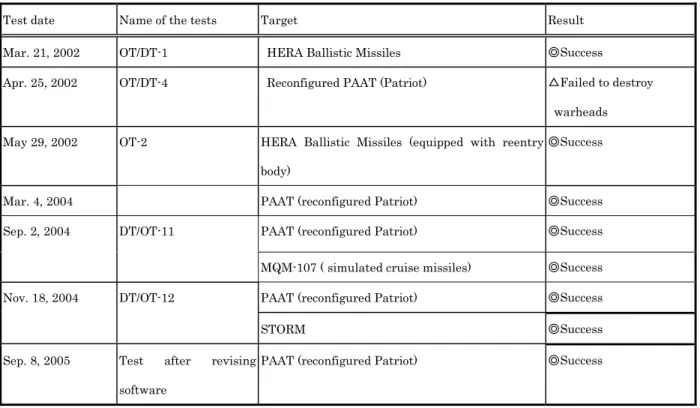
Issues and Measures of Policies
At the time of the North Korean missile launches in July 2006, Japan and the US exchanged detailed information on missile trajectories and impact locations. The government therefore believes that the exercise of the right to collective self-defense exceeds that limit and is not constitutionally permitted.”3. In other words, Japan is not allowed to intercept ballistic missiles targeting the United States or American armed forces because that would be interpreted as an exercise of the right of collective self-defense.
In such a situation, the U.S. homeland's exposure to ballistic missile attacks would hamper the U.S. deterrent against Japan. 12 Prime Minister Takeo Miki's statement to the Budget Committee of the House of Representatives, during the 77th session. Internationally, the Japanese interpretation of the 'peaceful use' of space is rather an exception.
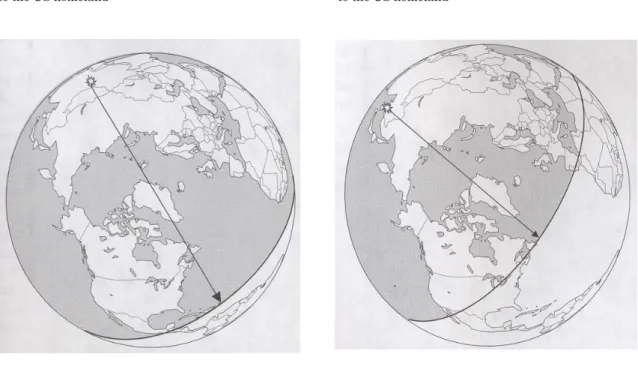
Enhancement of Japan-US Joint Operations Structure
Here, both Japan and the US will jointly respond to ballistic missile threats against Japan as well as regional emergencies. Japan and the US established working groups for each project to coordinate concrete measures for joint BMD projects. Therefore, it is preferable to establish unified project management systems based on close connection between Japan and the US.
Such differences may hinder projects related to the development and management of C2BMC, as these especially require closer coordination between Japan and the United States. Implementation of such functions requires the development of C2BMC that can provide effective coordination between Japan and the United States. Japan and the United States must each prepare ROEs in advance and coordinate the timing of their application.
Development of C2BMC
So it is inefficient both technologically and economically to establish independent C2BMC systems like the US. ⑧ In its development of C2BMC to MD, the US appears to distinguish command and control functions from information functions. The possibility of networking between Japan and the United States using LINK16,1 STADIL-J (Satellite Tactical Digital Information Link-J) 2 or JREAP (Joint Range Extension Application Protocol) 3 is under review.
In the United States and Europe, it is used for joint information sharing, classification and identification and navigation by the Army, Navy and Air Force, as JTIDS (Joint Tactical Information Distribution System) and MIDS (Multifunctional Information Distribution System). When developing C2BMC in Japan, it is necessary to have close coordination with the United States in determining information exchange requirements. In addition, as the need for joint operations increases, we must consider effective utilization of the U.S. forces' communications infrastructure.
Comprehensive Measures for Responding to Missile Attacks
Japan’s Participation in Arms Control, Disarmament and Non-Proliferation
In addition, arms control, disarmament and non-proliferation negotiations can function as channels of communication between hostile countries, as exemplified by the nuclear arms control negotiations conducted between the US and the Soviet Union during the Cold War. The US and the Soviet Union also signed the SALT I Interim Agreement at the same time as the ABM Treaty. US expansion of the INF and strategic nuclear forces would also force the Soviet Union to bear a greater burden.
The Soviet Union had a strong motive to avoid losing the nuclear arms race with the US by establishing a nuclear arms control treaty. The START I Treaty was truly epochal as the first treaty setting out the reduction of strategic nuclear weapons possessed by the US and the Soviet Union. Following the US announcement of its withdrawal from the ABM Treaty, the US and Russia began negotiating the reduction of their strategic nuclear weapons.
Establishing Deterrence Posture
In the US, the dominant concept at the time was that the US and the Soviet Union were in a. However, if the relationship between the US and Russia becomes strained, the US is likely to re-emphasize strategic nuclear forces as well as use missile defense. It is unlikely that the US and Russia will face such an extreme situation again.
The gap between the US and China on strategic forces is overwhelmingly in favor of the US. If so, the US can establish a denial capability that would effectively neutralize China's strategic nuclear forces. If the US aims to establish deterrence by denial against China, China must introduce some countermeasures.
Offensive Defense Measures
Offensive defense measures to attack missile launch sites can complement active defense through BMD, thereby enabling more effective response against ballistic missile attacks. In reality, however, Japan has no weapons capable of attacking enemy ballistic missile launch sites. On the other hand, the current interpretation of the Constitution makes it impossible to attack missile launch sites unless preparation for ballistic missile launches can be determined as intended for Japan.
On the other hand, Japan's ability to attack ballistic missile launch sites could complicate joint operations between Japan and the US. In addition, if Japan gains the ability to attack ballistic missile launch sites, Japan and the US could share the role in such attacks. The ability to attack ballistic missile launch sites could be added as upgrades to existing fighters and ground attack aircraft.
Passive Defense Measures
During the 1991 Gulf War, Israel demonstrated how passive defense worked effectively against ballistic missile attacks. The following sections describe Japan's situation and passive defense measures, particularly against ballistic missile attacks. One of the imperatives of passive defense is the rapid warning upon detection of signs of a ballistic missile launch and the rapid communication of such information to relevant ministries and agencies as well as to the general public.
However, not many people understand evacuation procedures in case of ballistic missile attacks. Basic guidelines for human protection issued by national governments and civil protection plans prepared by local governments are limited to basic plans and lack details on measures for ballistic missile attacks. Here again, responding to ballistic missile attacks requires the right combination of offensive defense, active defense and passive defense.
Defense Industrial/Technology Base
Given limited defense budgets, the significant flow of funds to the US means that Japan's defense industrial/technological base will have a smaller "piece of the pie", further weakening it and expanding technology gap between Japan and the US. The fact that Japan cannot conduct BMD tests domestically widens its technology gap with the US. Japan's dependence on the US for much of the development, production and upgrade work on its BMD system makes achieving self-sufficiency extremely difficult.
To resolve these issues, Japan must argue at every opportunity that Japan's BMD capability serves US interests. Given the technological gap between Japan and the US, it is inevitable that the US views Japan as less experienced and lacking credible operational data. Therefore, Japan must rely on the US for much of its pre-launch intelligence as well as early warning information.
Responses to Cruise Missiles
Export controls on cruise missiles can hardly be described as being strictly implemented as in the case of ballistic missiles. Since cruise missiles are cheaper, it is easier to use them for saturation attacks. Even in the case of surveillance by aircraft-based sensors, cruise missiles can be difficult to detect due to ground clutter.
Japan's Type 03 medium-range air defense missile (Chu-SAM) is said to have capabilities against aircraft, air-to-surface missiles (including those that can dive at sharp angles), and cruise missiles. The interception of cruise missiles involves detection, tracking and identification of incoming cruise missiles, and finally interception. Since cruise missiles fly at lower speeds in the atmosphere, kinetic warheads used for BMD may not provide enough energy to destroy cruise missile warheads.
